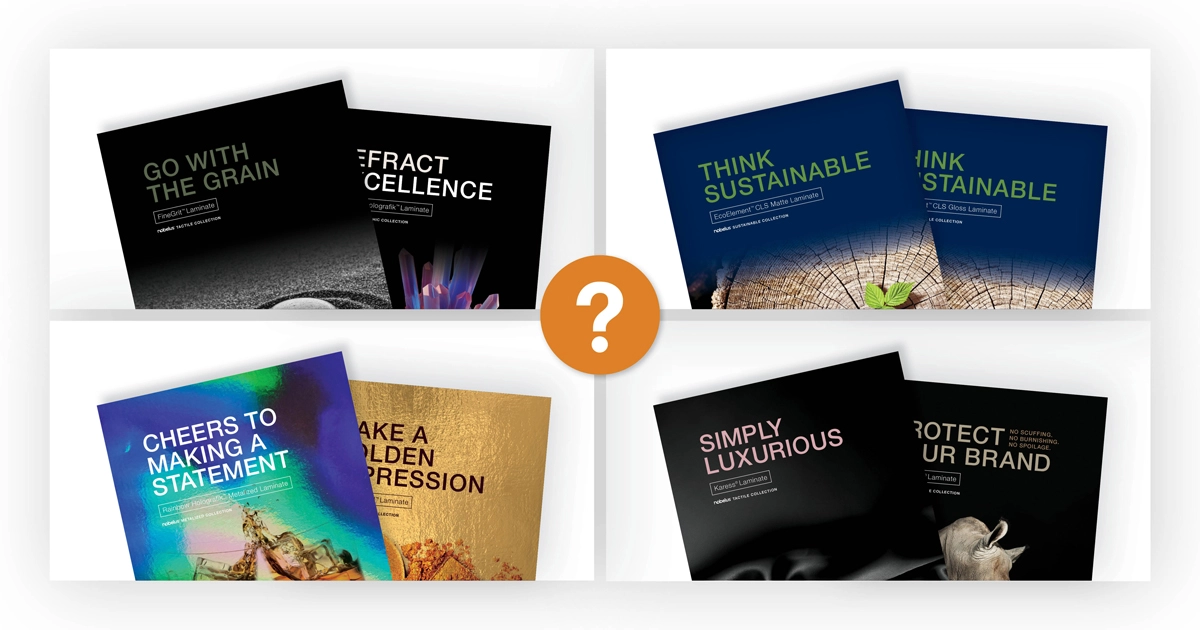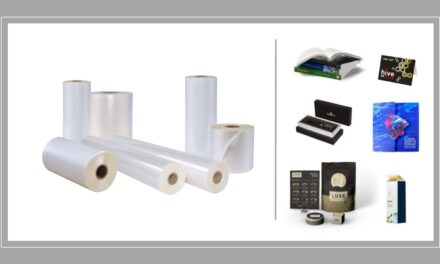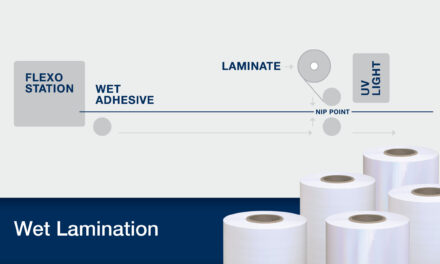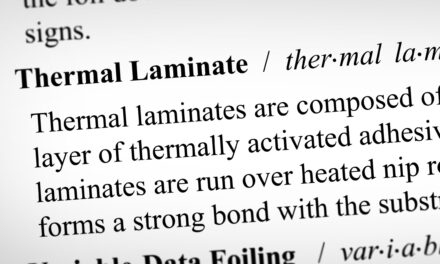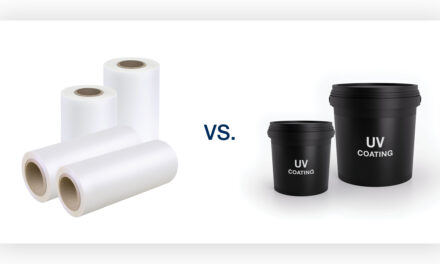THE ROLE OF LAMINATION FINISHES IN PRINT AND PACKAGING
Lamination does more than protect prints and packaging from moisture, grease, and dirt. It also plays a vital role in helping brands market their products and services to consumers. A laminate finish can take a simple sheet of paper, stand-up pouch, or label to new heights in terms of design elements and customer experience.
A carefully selected finish can help colors stand out on the shelf, draw in consumers with unique patterns and effects, and help generate brand loyalty by conveying superior quality when a package is unboxed or picked up in a retail setting. The print and packaging industry has access to more finishes than ever before, and knowing which one is the right choice for a given application is crucial. In this post, we will look at the wide range of lamination finishes available today and discuss what factors may impact a printer’s choice.
A DIVERSE RANGE OF FINISHES AND EFFECTS
Lamination finishes are available with a wide variety of visual, tactile, and even performance-enhancing effects. While not every finish will be right for every application, printers can often utilize different finishes for similar job types to give brands a broader range of options for how they market their products and services.
Many of these finishes can be found in different material types, thicknesses, and even film types with options that suit thermal lamination, solventless lamination, UV lamination, and more.
Basic Finishes
Gloss is typically considered the most basic of lamination finishes and is often the most cost-effective option, especially at higher volumes. This crystal-clear finish preserves the color accuracy of inks and can help make bright colors stand out while ensuring even the smallest details in a print remain sharp. Perhaps the only negative aspect of gloss is its tendency to reflect light in bright settings, sometimes obscuring parts of the design or making text difficult to read. Nearly every material type and thickness offer gloss as a finish option.
On the other hand, matte finishes are resistant to glare from bright lights and prevent reflections from distracting from the printed design. A matte finish gives prints a more muted look while still allowing colors to remain accurate to the original proof. It is the most popular finishing option for applications that need an extra visual appeal while still being cost effective.
Satin finishes lie somewhere between gloss and matte, possessing the flat, muted look of matte in conjunction with a shiny appeal that does not reach the same reflective levels as gloss. While Nobelus does not offer any basic satin finishes, many other finishes provide a similar effect.
Haptic Finishes
Soft-touch finishes, such as our own Karess® products, give prints and packaging a luxurious appeal with a rose petal soft surface. As the name Karess implies, a soft-touch finish invites consumers to interact closely with products and creates a memorable connection. The rich feel of this finish helps communicate that a product is of premium quality, making it perfect for high-end brands and service providers. Karess is available in a wide range of materials and thicknesses; to learn more, read our blog post, Which Type of Karess Laminate Do I Need?
In stark contrast, a rough-touch finish gives prints a gritty, stippled texture with the feel of light sand that can help convey a sense of durability or ruggedness for targeted marketing. Our rough-touch option, FineGrit™ Laminate, is extraordinarily durable in the face of scratches and scuffs, and because the gritty feeling is built into the surface of the laminate (unlike coatings, which are applied over the top of the laminate), the effect will not wear off even with repeated handling on store shelves or in multi-use applications.
While soft-touch and rough-touch options are most popular, many other tactile finishes are also available. Nobelus offers two specialty patterned laminates that provide a subtle tactile element to specialty applications: FineLinen™ Laminate and FineLeather™ Laminate. FineLinen gives prints an elegant cloth pattern, while FineLeather adds the rustic appeal of faux leather. The haptic effect of these products is not as pronounced as our rough-touch or soft-touch finishes, but they give applications a unique element in a highly competitive market.
Protective Finishes
A scratch-proof finish, such as our ScuffProof® products, employs a hard-coated surface over the laminate to prevent scratches, burnishing, and other types of abrasive damage from harming the integrity of printed designs. These types of laminates are ideal for packaging that will be transported over long distances or handled by many passersby throughout its shelf life.
In a similar vein are anti-smudging finishes, which prevent fingerprints, grease, and other similar contaminants from affecting the appearance of a print or package. SmudgeProof™ Laminate from the Nobelus catalog also features a subtle soft-touch feel in addition to its superior smudge resistance. These types of finishes are ideal for high-end applications where unsightly smudges could come across as unprofessional or dirty.
Sometimes certain matte finishes, such as UltraMatte™ Laminate, can also possess an elevated degree of scratch, smudge, and scuff resistance. UltraMatte in particular provides an incredibly strong matte effect that completely prevents reflections or glare, which means it is capable of protecting designs from nearly anything that might affect their visual appeal.
Eye-Catching Finishes
Finally, the world of lamination offers brands a nearly endless variety of holographic patterns and specialty effects that are especially striking. The Nobelus catalog offers Rainbow Holografik™, a shimmering, spectral finish that shifts colors as the viewing angle changes. Its pattern has no visible repeats, and because it is built into the surface of the laminate, it cannot be rubbed off. However, there are countless other patterns and effects available to printers who want to seek out a unique finish for their specialty applications.
Equally as eye-catching are the wide variety of metallic finishes available in the market. Spanning from standard gold and silver to colorful metallic holographic patterns, these unique finishes are sure to catch the eye of even the busiest potential customer. Many metallic finishes are opaque and therefore designed specifically to be overprinted when used as foil board for applications such as folding cartons and boxes.
HOW TO CHOOSE THE BEST FINISH FOR EVERY APPLICATION
Now that we have taken a comprehensive look at just how many options printers have when choosing their laminate finish, let’s consider what factors might affect whether a given finish is right for the end application. While printers have to take many things into account to ensure they are providing brands with the best solutions they can, we will focus on three main areas.
Performance
If a print or package does not meet expectations in terms of its performance, all other features become irrelevant. While all laminates provide some degree of protection, some finishes are more apt for this purpose than others. Consider if the application will be a single-use piece or if it will need to endure prolonged exposure to specific types of damage. Many applications, such as folding cartons, menus, trading cards, and book covers, either see repeated handling due to extended use or else pass through many hands as they are picked up and studied by consumers browsing store shelves.
In these cases, it is crucial that the printed design and overall integrity of the package be preserved. This is especially important when the product being sold is intended for consumption; damage such as burnishing can lead to spoilage, which poses a safety risk and can harm the reputation of a brand or packaging producer. Also consider what base materials are available for each finish. Certain base materials are more durable and stable than others, so printers may have to occasionally decide between the finish they want and the base material they need.
Aesthetic Appeal
Whether a package relies on visual effects, tactile elements, or a mixture of different features, it is important for a printer to know what aesthetic goals they want a finished product to achieve. Brands often have a very specific vision for not only how they’d like a package to look but also how they want that package to make prospective consumers feel. Printers should know how to market different finishes to brands by focusing on the main appeal of each option.
Products marketed as high end or luxurious will need a different aesthetic approach than items marketed to a more down-to-earth consumer profile. No one finish can fit every application, and knowing when to suggest a specialty finish as opposed to a more basic gloss or matte is key to the long-term success of any print finishing operation.
Cost
Finally, while premium finishes can certainly increase profit margins for certain products and market segments, cost is and will always be a core concern for the average print service provider. A printer must know their brands and market well enough to understand the demand for certain finishes and ensure that their selection will generate a return on investment. Basic finishes, such as gloss and matte, tend to be much more cost effective than premium finishes, including holographic effects and soft-touch films.
Still, the price point of materials is not the only consideration when determining if a finish is a wise use of funds. Specialty finishes can enable printers to enter new markets, revealing a host of new brands to partner with and opening new possibilities in what applications they can explore. While essential finishes are seen as a necessity in the industry, premium options can serve as an investment and a way to reach new heights as a print service provider.
READY TO EXPLORE THE NOBELUS PORTFOLIO?
If you’d like to see the full Nobelus catalog and explore the many finishes we offer, visit our product pages. We have thermal laminates and adhesive-free films that can meet the needs of the general commercial print, prime label, flexible packaging, and folding cartons spaces. Reach out to our team by phone or through the Contact Us page to request a sample roll and tell us more about your operation’s unique needs and goals. Our team is always ready and eager to help you find the materials you need to take your print and packaging to the next level.

